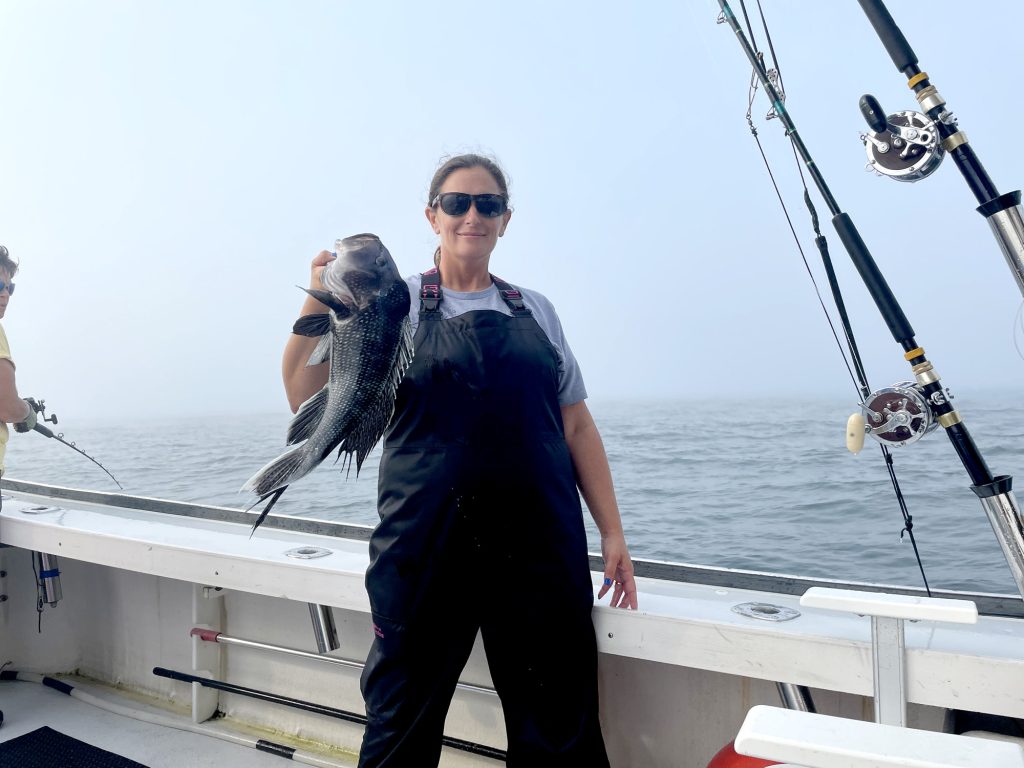
For many reasons, September is my second-favorite month of the year, only falling behind October for the top spot. This is when the air begins to finally begin cooling down, most tourists leave my quaint little shoreline town, and best of all, every type of fish from the surf to the canyons is on the feed! If there is one mistake, I see far too many anglers make it is in not getting an early enough jump on the action, and most find the best bites on the tail end of the feed once word has spread of the event. A word of warning, as well: keep an eye on Mother Nature as September can be a volatile month with hurricanes and nor’easters a common occurrence. Some storms turn on the bite as it approaches, others peak on the back side, and others still have a way of shutting things down altogether.

Beginning on the bottom, if you’re looking to feast on a cooler full of porgies and black sea bass now is the time to act! Both species can be found in great numbers this month, and they’re still close enough to shore to not require too long of a steam to find action, but for me, it’s really the lowly saltwater panfish that gets my attention in September. It is common to find schools of porgies so large and thick that at times it seems as if the ocean floor is paved many feet thick with them. Doubles, triples, and more are possible with the only real limit to how many fish you can catch on a single drop limited by the number of hooks you tie on and how adept you are at setting the hook. I prefer a simple hi-low rig with just two baited hooks as I spend more time catching this way as opposed to unhooking fish and rebaiting hooks. While the verdict remains out as to what is the best bait for porgies—squid, clams, worms, strip bait, etc.—for me there is no substitute for a Fishbites E-Z Bait in the long-lasting formula. Pretty much all flavors work equally well, and between the ease of use and the durability afforded by the layer of cloth sandwiched between water-activated gel, E-Z baits are a necessity for me when bottom fishing since discovering them several seasons ago. If I can’t get my hands on Fishbites, squid strips make a solid second choice.
One tactic I learned a few years back that I don’t see being employed often enough when hunting porgies is jigging for them. While bucktail jigs catch some large porgies, I prefer small metal and epoxy jigs for this application. The method is simple, just drop the jig down and fish it within 3 to 4 feet of the bottom. If the structure isn’t too sticky you can bounce it on the bottom, but as porgies—especially the bigger ones—relate to hard structure I find a simple yo-yo technique works best. Expect to catch fewer fish than your companion fishing bait next to you, but quite often the biggest fish of the day is going to be caught on the jig. What’s even better is that the likelihood of large black sea bass or keeper fluke coming up on that next drop is even greater as well.
Slams. Grand Slams. Super Slams. Whatever you want to call them, and whichever species you need to achieve the slam of your choice, September is the month where an inshore boater can run upon schools of feeding striped bass, bluefish, false albacore, bonito and in recent years, chub mackerel. Due to this, no matter what my primary target species is this month I ALWAYS have a rod rigged with some sort of tin or epoxy jig. Last year I was set up on some hard structure off Misquamicut, Rhode Island in about 30 feet of water on the 25th day of the month. The primary target for the trip was blackfish and black sea bass, and my fishing partner and I landed both species including the biggest sea bass I have ever caught which came in at several ounces over 6 pounds. But on top of these two species, we also had waves of rain bait being pushed past the boat all day by a variety of predators. By being prepared with a rod rigged and always at the ready, we also caught a bunch of bluefish, false albacore, and chub mackerel, and I added an exceptionally large bonito to the mix. I never got a weight on the bonito, but it was so large that when it hit the deck of the boat it began spitting up the very same 15-plus-inch chub mackerel that we had been catching earlier! We also added several hubcap-sized porgies and a keeper fluke to the box for the day, only missing the “Everything in Rhode Island Slam” by one fish as we somehow failed to pull a striped bass from the mix. From the western Sound to Cape Cod, this type of scenario plays itself out most days, you just need to be prepared to take advantage of it when the opportunity arises—don’t say I didn’t warn you!
Last up, we (hopefully) will be heading offshore this month in search of bluefin, yellowfin and mahi with plenty of “others” on the table. I had hoped that July would be a repeat of last year’s productivity on the nearshore tuna grounds, but this year’s bite is more on par with how it used to be before fishing became easy in recent seasons. On my last tuna hunt south of Block Island in the general vicinity of the Gully, we found tons of life in the form of humpback and minke whales as well as more common dolphin in that single trip than I have seen in any one season! We picked up “something small” (likely a bluefish) early in the day that got sharked before we would make a positive ID on it, and that set the table for a tough day of fishing. Twice the dead-sticked RonZ rod doubled over under the weight of a fish, but both times my partner and I scrambled to secure the jigging rod in hand before attending to the fish and both were lost. We also had a couple of quick hits on Nomad Streaker jigs, but by day’s end what started as a tuna trip ended as a spectacular whale watching trip.
Hopefully, by now the fish will have given up on their lockjaw ways and the waters south of Block Island past Nantucket and on up to the Cape will be teeming with cooperative thunnus. Perennial hot spots include the Ranger Wreck, Mud Hole, Dump, Shipping Lanes,Regal Sword, Crab Ledge, BC Buoy, BB Buoy, and right up the backside of Cape Cod and into the Bay. All methods are on the table in September including trolling, jigging, popping, and chunking; for the best success I advise being prepared for everything and let the fish tell you what they want—sound advice for all angling pursuits.
As noted earlier, next month is my favorite month of the year, and not just because my birthday falls on the 19th. October is when blackfishing really comes into its own, and since rediscovering this fishery several years ago I have become absolutely obsessed with targeting them from shore, kayak and by boat.
